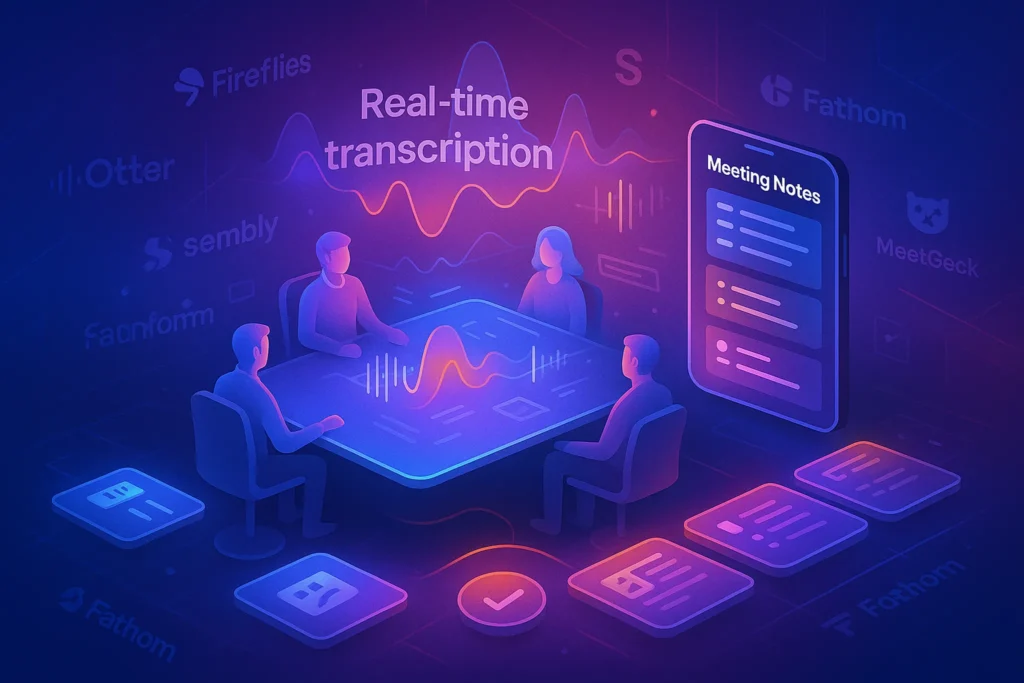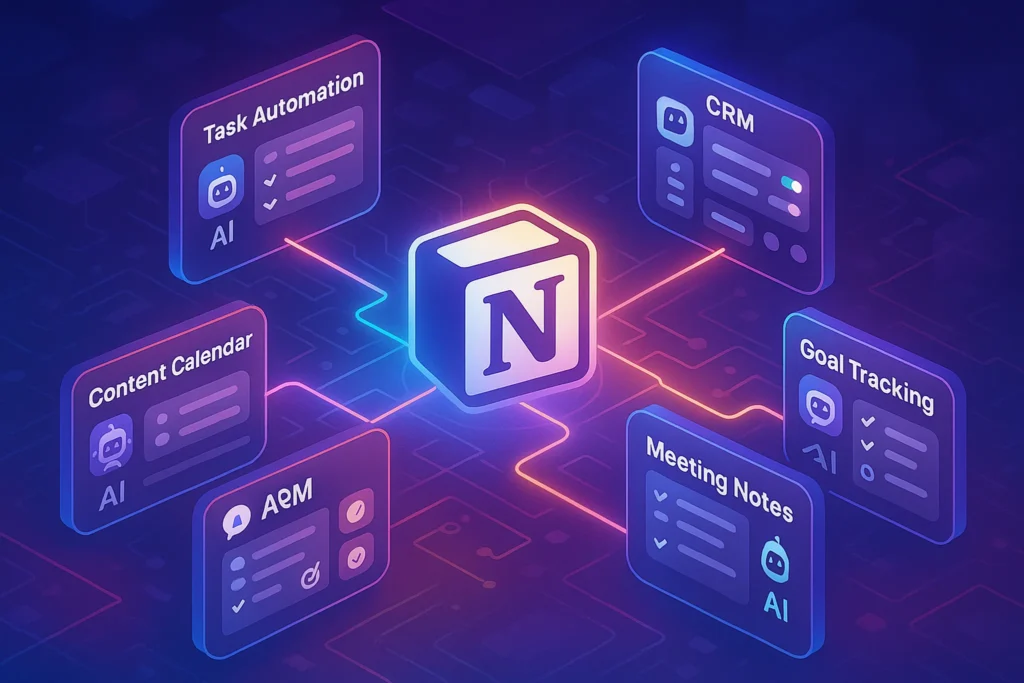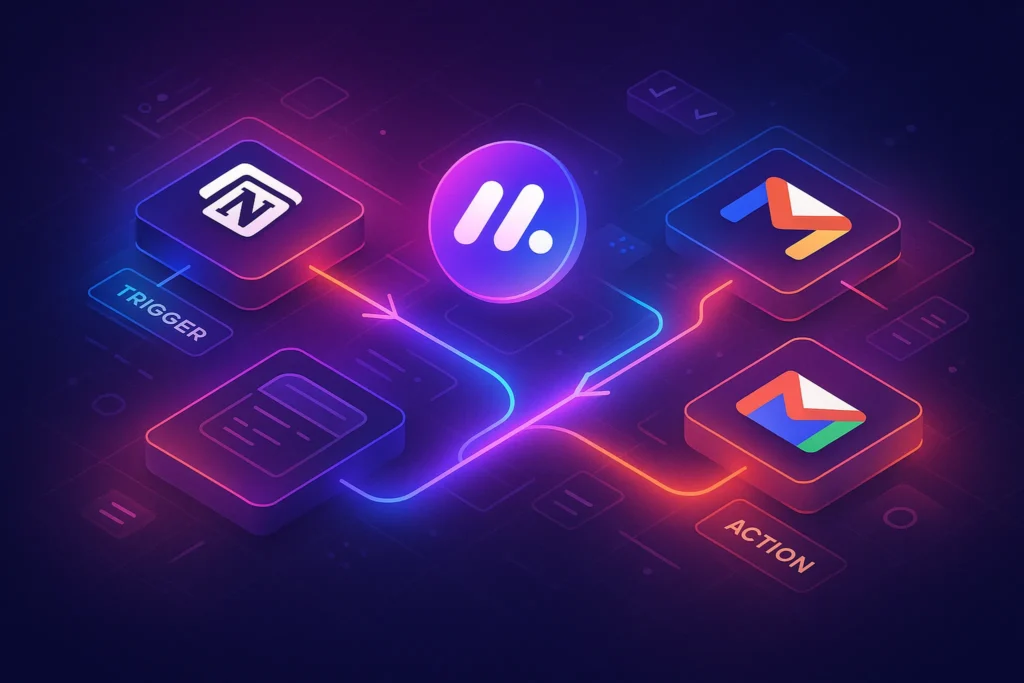-This post may contain affiliate links. If you click on one and make a purchase, I may earn a small commission at no extra cost to you.-
🤯 Introduction: AI Just Took Your Notes — And Then Some
Taking notes during meetings is the fastest way to lose focus, miss insights, or forget who said what. But what if your assistant could listen, transcribe, summarize, and even create tasks — all while you’re fully engaged in the conversation?
That’s exactly what today’s AI meeting assistants are built for. Whether you’re a solo freelancer, part of a marketing team, or running a growing coaching business, these tools automate the note-taking process so you never miss a beat again.
In this guide, we’ll explore the best AI-powered meeting tools that do way more than just transcription. From real-time highlights to calendar integrations and even CRM sync, these assistants are changing how we work — and think.
And if you’re building a full AI-powered workflow, don’t miss our deep dive into AI automation assistants and freelancer-focused AI tools to extend your productivity even further.
📊 AI Meeting Tools Reviewed
1. Fathom – 🎧 AI Meeting Summaries in Seconds
Fathom is one of the most generous free tools on this list. It offers high-quality real-time transcription, automatic highlight generation, and instant summaries — all without charging you a cent. It also supports multiple languages and directly integrates with Zoom.
It’s particularly popular among coaches, solo creators, and startup founders who want pro-level tools without the subscription fatigue.
👤 Use-Case: A personal development coach who runs 1-on-1 Zoom sessions and needs instant summaries to reflect on or share with clients.
⚖️ Mini Comparison: Fathom is stronger than tl;dv in terms of free features, but lacks the multi-platform recording that tools like Supernormal or Fireflies offer.
💬 “I started using Fathom just to test it — and now I can’t imagine Zoom calls without it. The real-time highlights are so on-point, I rarely need to rewatch anything.”
What It Is:
Fathom is an AI-powered meeting assistant that integrates directly with Zoom, Google Meet, and Microsoft Teams. It automatically records, transcribes, and summarizes your meetings in real-time.
Key Features:
-
One-click Zoom integration
-
GDPR-compliant and SOC 2 certified
-
Free forever plan with unlimited meetings
-
Summaries broken down by speaker, topic, and task
Who Should Use It:
Perfect for freelancers, consultants, and solopreneurs who want lightweight, automated note-taking without a monthly fee.
Why It Works: Fathom is designed for speed and simplicity. As soon as a meeting ends, the tool generates a structured summary including highlights, action items, and questions asked—all viewable within a clickable interface. Great for solo professionals, freelancers, and fast-moving teams.
-
What it does: Auto-records in Zoom, Google Meet, Teams. Produces summaries within 30 s and lets you query key points.
-
Pros: Free forever, lightning-fast summaries, secure (no training on your data).
-
Cons: Basic integrations, limited output customization.
Why It’s Great:
Fathom’s biggest advantage is its speed and simplicity. Within 30 seconds after your meeting ends, you receive a neatly organized summary including highlights, action items, and key moments—all without lifting a finger.
🔗 Try Fathom →
“The free version is very usable”—and it works seamlessly with most major platforms.
2. Otter.ai / OtterPilot – 🗣️ Real-Time Notes + Speaker Labels
Otter.ai has become the go-to AI assistant for anyone looking to record and transcribe meetings live — across platforms like Zoom, Google Meet, and Teams. But Otter goes further than raw transcripts. It offers automated summaries, action item detection, and even speaker identification, all in a neat, searchable interface.
If you’re someone who jumps between back-to-back calls or needs to send meeting recaps to clients or teammates, Otter saves hours of follow-up work. You can even collaborate inside the Otter workspace, leaving comments on sections of a transcript — like Google Docs for meetings.
👤 Use-Case: A freelance consultant who meets with clients weekly and needs fast, clean summaries to stay on top of follow-ups.
⚖️ Mini Comparison: Compared to Fireflies, Otter is slightly more intuitive and visually streamlined — but it lacks deep CRM or task integrations.
💬 “When I used Otter for my early coaching calls, it felt like having a silent co-pilot. I didn’t worry about missing a detail — and my clients appreciated the follow-up docs.”
What It Is:
Otter is one of the most popular transcription services in the market. With OtterPilot, it becomes a fully autonomous meeting assistant—capturing live notes, identifying speakers, and even pulling screenshots of shared slides.
Key Features:
-
Auto-capture of slides and visuals
-
Live transcription with speaker identification
-
Real-time collaboration and editing
-
Works with Zoom, Meet, and Teams
Who Should Use It:
Teachers, students, team leaders, and business owners who need reliable multi-speaker capture with visuals.
Why It Works: Otter does more than transcribe—it listens, processes, and helps with visual context. It captures slides automatically during screen sharing and integrates well with Zoom. Its “Live Summary” mode works great during team meetings or lectures.
-
What it does: Provides live captions, post-meeting summaries, speaker tracking, and image capture for slides.
-
Pros: Great for multi-speaker sessions and slide-heavy webinars; free plan available.
-
Cons: Advanced features reserved for paid tiers.
Why It’s Great:
Otter is highly accurate, supports collaboration, and includes real-time notes, which makes it ideal for teams. The mobile app is also top-notch, letting you review conversations on the go.
3. Fireflies – 🔥 Searchable Voice Intelligence
Fireflies is more than just a recorder — it’s a full-blown productivity layer for meetings. It connects with your calendar, joins meetings automatically, records and transcribes them, but also turns key highlights into searchable, taggable action items. You can even set it to push tasks to your CRM or project tools like Trello or Asana.
Where Otter stops at transcription, Fireflies moves into workflow automation — making it especially useful for sales, marketing, and operations teams.
👥 Use-Case: A sales team lead who wants every discovery call auto-logged into HubSpot and turned into follow-up tasks without lifting a finger.
⚖️ Mini Comparison: Otter = cleaner interface + better summaries. Fireflies = deeper integrations + automation.
📌 If you’re serious about automating beyond meetings, you’ll love our guide to Zapier Automations for Creators — perfect companion to Fireflies’ built-in syncs.
💬 “Personally, Fireflies felt like the bridge between meetings and action. It doesn’t just record — it connects your meetings to the rest of your workflow.”
What It Is:
Fireflies is a powerful AI notetaker focused on making your meeting content searchable and actionable. It integrates with all major conferencing tools and stores transcripts in a searchable voice database.
Key Features:
-
Smart keyword/topic tagging
-
Speaker analytics and talk-time tracking
-
Zapier + CRM integrations
-
Email recaps and Slack summaries
Who Should Use It:
Ideal for remote teams, project managers, and content creators who want an organized record of conversations.
Why It Works: Fireflies stands out with its focus on collaboration and analytics. You can search past meeting transcripts like a knowledge base and track talking time, topics, and decisions. Works well with remote teams and async updates.
-
What it does: Records across platforms; auto-tags topics and assistant teams with analytics for discussion tracking.
-
Pros: Powerful integrations, topic identification tools.
-
Cons: Limited free options; may require manual cleanup.
Why It’s Great:
You can search for anything that was said across your entire meeting history. It also supports tagging, sharing, analytics, and team collaboration tools—all with solid transcription accuracy.
4. Avoma – 📊 Revenue-Centric Meeting Intelligence
What It Is:
Avoma goes beyond transcription by adding AI-powered coaching and sales intelligence. It offers speaker sentiment analysis, CRM sync, meeting templates, and detailed post-call insights.
Why It’s Great:
It’s not just about what was said—it’s about improving how your team communicates. Avoma helps with sales training, deal tracking, and improving team performance.
Key Features:
-
AI coaching insights
-
Custom meeting templates
-
Automated CRM entries
-
Sentiment & engagement tracking
Who Should Use It:
Sales teams, customer success leads, and revenue operations managers looking to optimize performance and processes.
Why It Works: Avoma doesn’t just record—it coaches. Ideal for sales teams, it highlights talk ratios, sentiment trends, and follow-up items, and integrates with CRMs. Think of it as Gong for small-to-mid teams.
-
What it does: Generates coaching insights, sentiment analysis, and seamless CRM/task integrations.
-
Pros: Excellent for teams doing sales or client meetings.
-
Cons: Pricey; overpowered for solo users.
5. Fyxer – 📬 Inbox + Meeting in One
What It Is:
Fyxer is a unique blend of virtual assistant and meeting assistant. It doesn’t just take notes—it follows up by drafting emails, organizing tasks, and summarizing conversations in your inbox.
Why It’s Great:
If your workflow is heavily email-based, Fyxer becomes a digital right-hand—integrating post-meeting actions directly into your communication flow.
Key Features:
-
Email writing and inbox sorting
-
Post-meeting summary + action plan
-
Hybrid human + AI support
-
Data privacy with SOC 2 and ISO 27001
Who Should Use It:
Executives, consultants, and founders who manage large volumes of communication and want hands-off follow-ups.
Why It Works: Fyxer bridges post-meeting friction by jumping straight into your inbox—suggesting replies, drafting follow-ups, and attaching summaries. It’s the only assistant that blends meetings with email action seamlessly.
-
What it does: Hoovers meeting notes and follows up in your inbox—drafting replies, sorting emails, summarizing discussions.
-
Pros: Auto-sorts and writes emails; SOC 2/ISO27001 security.
-
Cons: Still early-stage; needs inbox integration.
6. Supernormal — Not Just Notes, but Smart Recaps
Supernormal focuses on creating clean, digestible meeting notes — formatted like a professional recap email. It connects with Google Meet, Zoom, and MS Teams, and its summaries can be customized by tone, content type, and audience (e.g. internal team vs client follow-up).
It shines when you want your post-meeting workflow to look polished and consistent — without needing to edit anything yourself.
👥 Use-Case: A project manager juggling multiple stakeholders who needs quick, readable recaps after every sync or stand-up.
⚖️ Mini Comparison: Supernormal is cleaner than tl;dv in recap formatting, but doesn’t do real-time editing like Fathom.
💬 “This is my go-to for external meetings — I literally hit ‘Send Recap’ and it feels like I had a human assistant draft it for me.”
🔹 tl;dv — AI-Powered Recaps for Remote Teams
tl;dv stands for “too long; didn’t view,” but it ensures your meetings are never lost in the chaos. It can record calls, highlight key moments, and even summarize discussions in Slack-style bullets. It supports Google Meet and Zoom, with live note-taking and timestamped bookmarks.
If you’re in a remote team and want asynchronous visibility into discussions, tl;dv is a great choice.
👤 Use-Case: A remote design team lead who wants to share key decisions with async teammates after daily standups.
⚖️ Mini Comparison: tl;dv is more async-team focused, while Fathom and Otter lean toward solo summaries.
💬 “I used to manually timestamp key points. tl;dv does it live — and I’m now the only person on my team who doesn’t dread watching missed calls.”
🛠️ What Makes a Great AI Meeting Assistant
These are the criteria we used to evaluate each tool:
| Feature | Why It Matters |
|---|---|
| ✅ Transcription & Summaries | Accurate capture and clear, structured output |
| 📝 Action Item Extraction | Saves time turning points into tasks |
| 🔄 Integration Support | Slack, Notion, CRM, Zapier connectivity |
| 🔐 Privacy & Security | Encryption, data protection standards |
| 💵 Pricing Structure | Free plans vs paid upgrades |
📚 Use Case Showcase – Who Should Use What?
Not all tools serve the same role. Here’s how different professionals can match the right AI meeting assistant to their workflows:
| Persona | Best Tool | Why It Works |
|---|---|---|
| 👩💼 Solo Entrepreneur | Fathom | No setup, instant summaries, and it’s free—perfect for lean solo workflows. |
| 🧑🏫 Educator / Trainer | Otter.ai | Live transcripts + slide detection helps both students and lecturers. |
| 👥 Remote Team Lead | Fireflies | Topic tagging and async sharing boost transparency and follow-ups. |
| 💼 Sales Manager | Avoma | Deal insights, sentiment analysis, and CRM sync streamline pipeline reviews. |
| 📬 Busy Exec + Inbox-Heavy | Fyxer | Combines email drafting with meeting wrap-ups—pure time-saving magic. |
🚧 Common Mistakes to Avoid When Using AI Meeting Assistants
Even the smartest AI tools can backfire if used incorrectly. Here are a few common traps to watch out for:
-
❌ Not informing participants: Always let people know the meeting is being recorded. Skipping this can lead to trust issues — or worse, legal trouble.
-
❌ Relying 100% on auto-summary: AI-generated summaries are helpful, but they can miss tone or nuance. Always skim the full transcript for important context before sending a recap.
-
❌ No system for storage: Recordings and transcripts pile up fast. If you don’t organize them by project or client, they become digital clutter.
-
❌ Ignoring integrations: If your AI tool supports sync with Slack, Notion, or CRM — use it! Otherwise, you’re missing out on half the value.
🧠 Nerd Verdict: What I Use (and Why)
“From free & fast to feature-rich analytics, these tools reclaim your time and reduce meeting overhead. Fathom is unbeatable for individuals; Otter is reliable and versatile; Avoma serves teams well; and Fyxer smartly bridges meetings and email. Choose the one that matches your workflow, but don’t wait to try at least one today.”
After testing dozens of meeting assistants, my personal workflow now uses Fathom for solo Zoom calls and Fireflies for any client or cross-platform session. Fathom gives me fast summaries for reflection, while Fireflies connects directly to my task manager and CRM.
If you’re just starting out, Fathom or tl;dv are excellent free options. But if your meetings impact revenue or team ops, go with Fireflies or Otter and don’t look back.
The key takeaway? Pick one that fits your current workflow and stick with it. Familiarity will make the tool way more valuable over time.
❓ FAQ: Nerds Ask, We Answer
Which meeting assistant is best for solo users?
Fathom is free, fast, and easy to use without setup complexity.
Can I link meeting notes to Notion?
Yes—Fathom supports Zapier integration to push summaries and clip info directly into Notion.
Are these tools secure?
Yes—most adhere to enterprise-grade security protocols like SOC 2 and ISO 27001.
Can I use these tools for in-person meetings too?
A: Yes! Most of them let you record voice directly from your device. Otter, for instance, has a great mobile app for this.
Are these tools secure for confidential meetings?
A: Most use encrypted storage and privacy controls. That said, for highly sensitive calls, always check their compliance (SOC 2, HIPAA, etc.).
What happens if the AI gets something wrong in the summary?
A: Always review key action points before forwarding. These tools are smart — not flawless.
💬 Would You Bite?
Which AI assistant would you add to your meetings—Fathom, Otter, Fireflies, Avoma, Supernormal or Fyxer?
👇 Drop your pick in the comments—and tell us why! Let’s trade notes on notetaking



